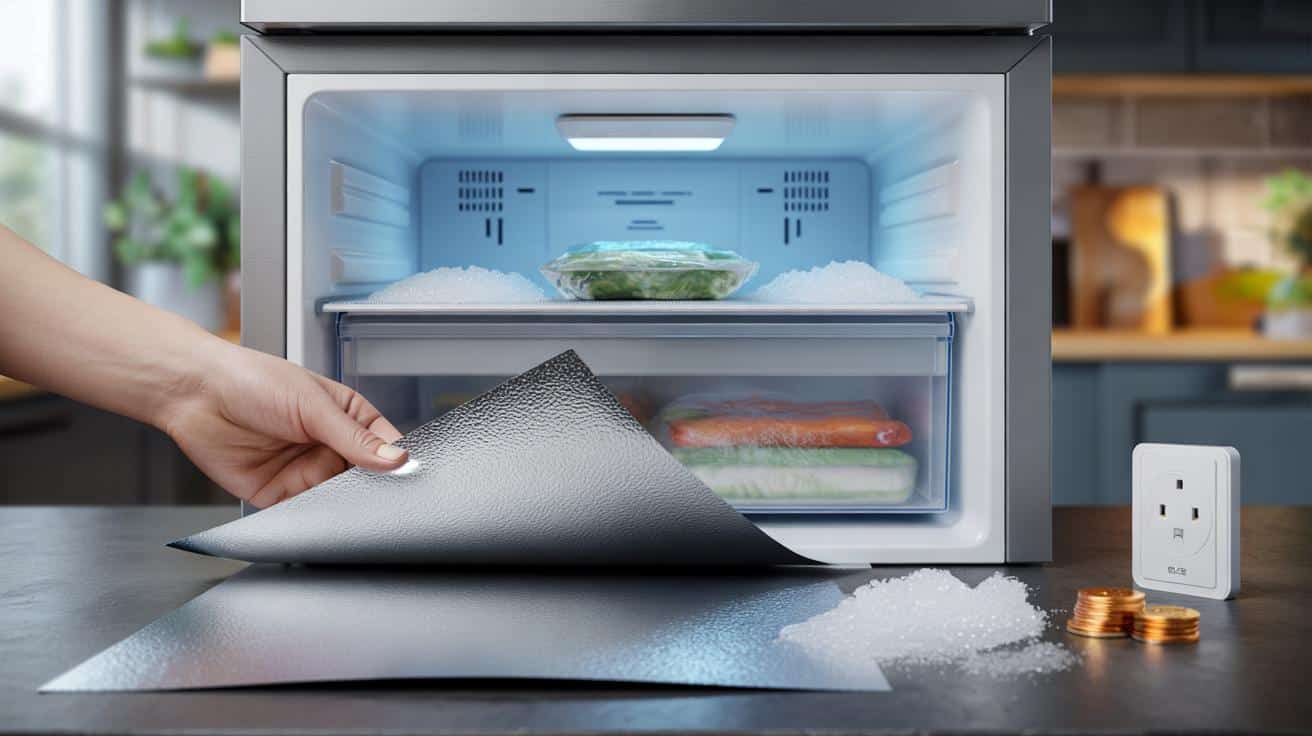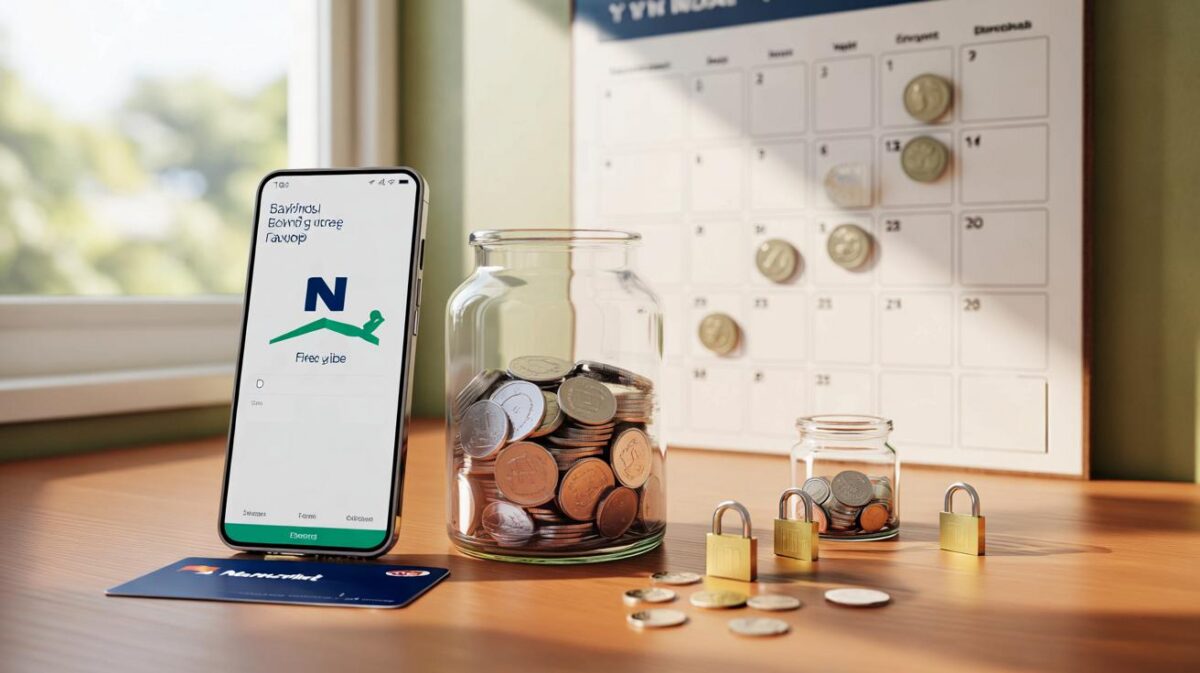Behind the hum of your freezer, frost quietly forms, nudging up bills and jamming drawers. A simple liner trick, borrowed from savvy households, now claims to cut the faff and the cost without touching a single thermostat.
Why a strip of foil is turning up in home freezers
Moist air rushes in each time you open the door. It hits very cold metal, and frost forms a stubborn crust. That crust insulates the cooling surfaces, the compressor runs longer, and drawers start sticking. A thin sheet of aluminium changes where that frost lands. It turns an hour of scraping into a quick peel-and-swap.
Foil does not prevent frost. It gives ice a smooth, removable skin so you clear buildup before it hurts performance.
Aluminium also has two advantages your plastic bins lack. It conducts heat well during a manual defrost, so it warms quickly and releases ice without force. And its smooth face makes ice less clingy, which means fewer gouges in brittle plastics and less stress on rails and runners.
What frost does to your bills
A few millimetres of frost act like a thermal blanket. Many models show a measurable rise in consumption once ice reaches roughly 2–3 mm thick. Real‑world homes often see 5–15% extra use when frost is allowed to grow unchecked.
Take a 350 kWh‑per‑year freezer. Keep frost in check and you could avoid 20–50 kWh of waste across a year. At typical UK tariffs of 24–30p per kWh, that’s about £5–£15 saved, plus drawers that slide when you need them.
The saving comes from staying ahead of frost, not from any magical cooling effect. Airflow and clean surfaces do the heavy lifting.
Set‑up: the 10‑minute version
You can line a freezer in one short session. Focus on flat, non‑vented areas and leave the mechanics alone.
- If you’re doing a full reset, switch off and unload into a cool bag. For a quick refresh, work fast with the door ajar.
- Cut heavy‑duty foil into flat panels to fit shelves, the floor of the compartment, and the tops of drawers.
- Keep a clear gap around vents, fans, sensors and drain channels. Leave at least a finger’s width near any visible coils.
- Lay sheets flat without tape. Do not cover gaskets. Return food with small spaces between packs to protect airflow.
- When you see white buildup, lift out the frosty sheet, fit a fresh panel, rinse and dry the old one for reuse.
Airflow matters more than any liner. Never cover vents or the light/temperature sensor with foil.
When to skip or adapt the hack
- No‑frost cabinets already defrost themselves; liners can rattle, impede air and muddle sensors.
- Chest freezers with exposed tubing need clearance; metal‑on‑metal contact can cause noise or damage.
- Tight‑tolerance drawers may rub; use thinner sheets or skip the drawer tops.
- Avoid tape on seals and trims; adhesives degrade gaskets and create leaks.
- Acidic spills (tomato, brine) can pit aluminium; put those foods in trays or sealed tubs.
Your weekend game plan
Block out 30 minutes. Unplug. Move food to a cooler. Lay warm, damp towels on stubborn ice for five minutes, then wipe. Fit foil only to flat areas that don’t breathe. Power back on and set a monthly two‑minute reminder to inspect and swap frosty panels. That habit prevents thick layers and stabilises energy use.
Quick fixes for common freezer gripes
| Problem | Quick action | Avoid |
|---|---|---|
| Thick frost | Warm towel to release ice, fit foil panels for next cycle | Knives or metal scrapers near coils |
| Sticking drawers | Foil on drawer tops, a whisper of food‑safe silicone on rails | Bulky liners that snag runners |
| Higher bills | Keep frost below 3 mm, check door seals monthly | Overpacking that chokes airflow |
| Bad odours | Open baking soda box, wipe interiors with diluted vinegar | Perfumed sprays near food |
The physics in plain words
Aluminium conducts heat rapidly compared with plastic. During a manual defrost, a thin sheet warms and releases the ice layer first, so the mess comes away in one piece. During everyday use, the smooth surface gives frost somewhere easy to form and easier to remove. The cooling still happens at the evaporator; the foil just makes housekeeping quicker.
Does the maths add up for you?
Run a rough tally. Note your freezer’s kilowatt‑hour label. Assume a 5–15% rise if frost builds. Multiply that slice by your tariff. On 28p per kWh, avoiding 20–50 kWh of waste returns £5.60–£14 a year. Add the time saved from scraping and the reduced chance of snapping a drawer rail, and many busy households will take the win.
If you want proof, use a smart plug with kWh tracking for a fortnight after a clean, then again two months later while swapping liners. A small drop in average daily consumption confirms the routine helps.
Small habits add up: clear space around vents, fast door openings, tidy swaps of any frosty liner, and regular seal checks.
Sustainability, care and safety
Pick heavy‑duty sheets. They resist tearing and survive repeated cycles. Rinse, dry and store panels flat for reuse. Recycle clean aluminium where accepted; scrunch small offcuts into a fist‑sized ball so they don’t fall through sorting gear. Fold edges over once to blunt them. If a panel buzzes when the fan runs, trim it smaller until silence returns.
For those counting carbon, trimming 20–50 kWh avoids roughly 3–12 kg of CO₂ on a typical UK grid mix, depending on your supplier. Not a revolution, but a neat nudge in the right direction.
Who benefits most
Households that open the freezer frequently—families, batch‑cookers, shared homes—pull in more humid air, so frost grows faster. Humid kitchens and coastal climates suffer the same fate. A peel‑off layer saves time and protects fittings in those cases. If you live with a compact, auto‑defrost appliance, the payoff is smaller; concentrate on spacing items, cooling leftovers before freezing, and testing door gaskets with a paper strip. If the paper slips when closed, the seal needs attention.
Extra gains from the same roll
Aluminium isn’t just a liner. Crumple a ball to lift carbon on grill grates and the outside of cast iron without harsh scrapers. Tuck a sheet under an ironing board cover to reflect heat for faster crease removal on cotton and linen. Skip the viral “battery hat” fix—wedging foil to make a weak battery work risks heat and leaks. Replace the cell instead.
Two final tweaks to widen the impact
Map your freezer so you find things fast: meat low, bread near the door, veg in sealed tubs. Cold air sinks, so this layout helps stability and speeds retrieval. Label shelves; seconds saved equal less moisture pulled in. For bills, pair the liner routine with a quarterly seal clean and a five‑minute audit of airflow—no bags draped over vents, no boxes jammed to the back wall. These boring checks do the quiet, reliable work the foil can’t do alone.








